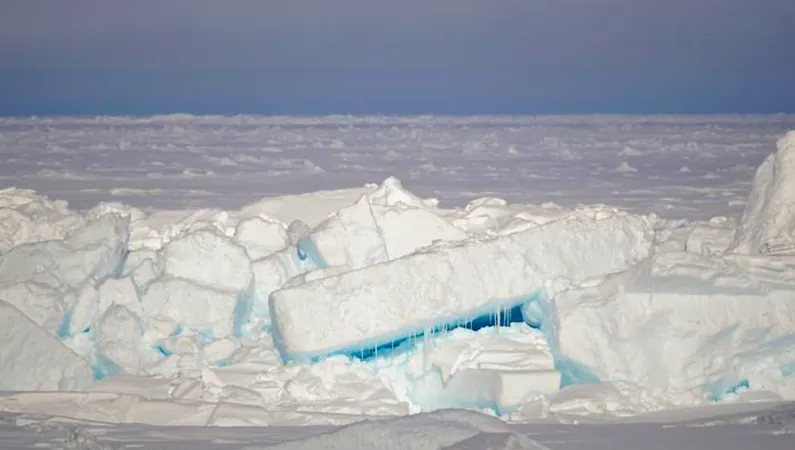
Shocking New Research Reveals Alarming Decline in Arctic Pressure Ridges as Multiyear Ice Melts
2025-01-08
Author: Arjun
Introduction
The Arctic is facing unprecedented transformations as a significant reduction in multiyear ice leads to alarming changes in the pattern and presence of pressure ridges. These critical formations, created when ice floes collide and stack upon each other, not only serve as natural barriers for maritime shipping but also play a vital role in sustaining the Arctic ecosystem.
Groundbreaking Study
A groundbreaking study published in *Nature Climate Change* by researchers from the Alfred Wegener Institute (AWI) sheds light on these concerning trends. Over the past three decades, aerial surveys and satellite data have documented a troubling decline in the summer ice coverage, with the thickness of ice floes decreasing and their mobility accelerating. Until recently, the specific impacts of climate change on pressure ridges remained unclear, as satellite observation of these formations has only been feasible for a few years.
Importance of Pressure Ridges
These ridges, which can rise one to two meters above the waterline and extend as deep as 30 meters below, are crucial for energy balance, nutrient cycling, and are a habitat for various Arctic species. The decline of these formations, however, poses a risk to the survival of many marine animals, including polar bears, which rely on pressure ridges for shelter and breeding.
Research Findings
During an extensive research initiative spanning from 1993 to 2023, the AWI team conducted laser-based analysis from aircraft, covering approximately 76,000 kilometers. Their findings reveal that in areas north of Greenland and Fram Strait, the frequency of pressure ridges is diminishing by 12.2% and their height by 5% per decade. Specifically, in the Lincoln Sea region, frequency decreases are even steeper, with a decline of 14.9% and a height reduction of 10.4% per decade.
Expert Insights
Dr. Thomas Krumpen, sea-ice expert and lead author of the study, highlights that the decrease in pressure ridges can be attributed to the extensive melting of older, more stable ice. While one might assume that younger ice would lead to more frequent ridge formation due to its malleability, the rapid loss of multiyear ice—characterized by abundant ridges—overrides this potential increase.
New Metrics and Observations
The researchers have developed a new metric utilizing comprehensive observational data to aim at understanding these changes across the Arctic. Their analysis indicates that regions with the most significant decline in ice age, such as the Beaufort Sea and the Central Arctic, show the steepest decrease in pressure ridges.
Data Collection Methodology
The data collection and analysis utilized advanced laser scanning technology aboard research aircraft, which conducted low-level flights to create precise terrain models. The AWI's Polar 5 and Polar 6 aircraft are equipped to operate in extreme conditions, and are essential for ongoing studies in this rapidly changing environment.
Implications for Arctic Ecosystem
To understand the implications of these shifts on the Arctic ecosystem, further models must encompass both physical transformations and biological processes. The increase in pressure ridges that do not survive their initial summer is a pivotal concern, coupled with the paradox that, despite decreased frequency and size, the drift speed of Arctic ice has actually risen owing to factors such as intensified ocean currents or smoother ice surfaces.
Future Research and Collaboration
In a bid to address these complexities, AWI has made its extensive dataset publicly accessible. This encourages collaborative efforts among researchers aimed at enhancing our understanding of Arctic dynamics.
Upcoming Expedition
Looking forward, an expedition aboard the research vessel Polarstern is scheduled for next summer, which will focus on analyzing the biological and biochemical contrasts between different types of floes and pressure ridges. Combining ship and aerial observations, researchers hope to gain vital insights into the interconnectedness of Arctic ice, climate change, and ecosystem health.
Conclusion
As Dr. Krumpen notes, “We must fully comprehend the intricate environmental systems at work in the Arctic to create effective conservation strategies for this fragile region.

 Brasil (PT)
Brasil (PT)
 Canada (EN)
Canada (EN)
 Chile (ES)
Chile (ES)
 Česko (CS)
Česko (CS)
 대한민국 (KO)
대한민국 (KO)
 España (ES)
España (ES)
 France (FR)
France (FR)
 Hong Kong (EN)
Hong Kong (EN)
 Italia (IT)
Italia (IT)
 日本 (JA)
日本 (JA)
 Magyarország (HU)
Magyarország (HU)
 Norge (NO)
Norge (NO)
 Polska (PL)
Polska (PL)
 Schweiz (DE)
Schweiz (DE)
 Singapore (EN)
Singapore (EN)
 Sverige (SV)
Sverige (SV)
 Suomi (FI)
Suomi (FI)
 Türkiye (TR)
Türkiye (TR)
 الإمارات العربية المتحدة (AR)
الإمارات العربية المتحدة (AR)